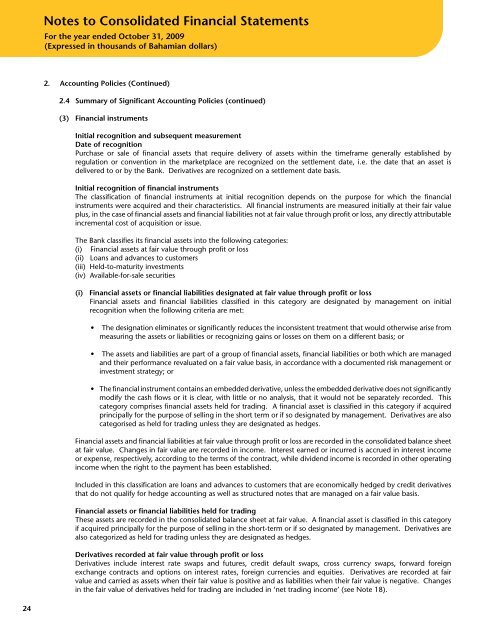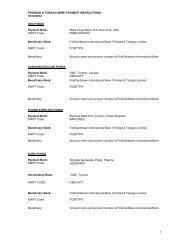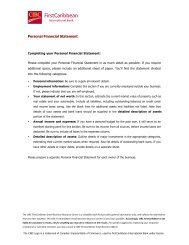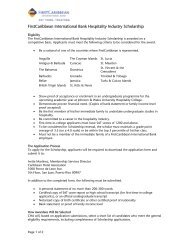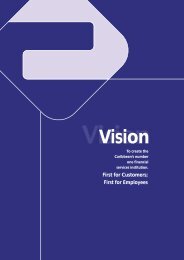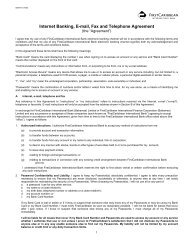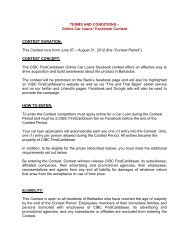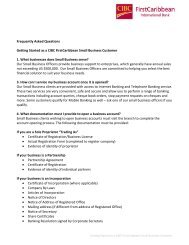FirstCaribbean International Bank (Bahamas) Limited
FirstCaribbean International Bank (Bahamas) Limited
FirstCaribbean International Bank (Bahamas) Limited
- No tags were found...
Create successful ePaper yourself
Turn your PDF publications into a flip-book with our unique Google optimized e-Paper software.
Notes to Consolidated Financial StatementsFor the year ended October 31, 2009(Expressed in thousands of Bahamian dollars)2. Accounting Policies (Continued)2.4 Summary of Significant Accounting Policies (continued)(3) Financial instrumentsInitial recognition and subsequent measurementDate of recognitionPurchase or sale of financial assets that require delivery of assets within the timeframe generally established byregulation or convention in the marketplace are recognized on the settlement date, i.e. the date that an asset isdelivered to or by the <strong>Bank</strong>. Derivatives are recognized on a settlement date basis.Initial recognition of financial instrumentsThe classification of financial instruments at initial recognition depends on the purpose for which the financialinstruments were acquired and their characteristics. All financial instruments are measured initially at their fair valueplus, in the case of financial assets and financial liabilities not at fair value through profit or loss, any directly attributableincremental cost of acquisition or issue.The <strong>Bank</strong> classifies its financial assets into the following categories:(i) Financial assets at fair value through profit or loss(ii) Loans and advances to customers(iii) Held-to-maturity investments(iv) Available-for-sale securities(i) Financial assets or financial liabilities designated at fair value through profit or lossFinancial assets and financial liabilities classified in this category are designated by management on initialrecognition when the following criteria are met:• The designation eliminates or significantly reduces the inconsistent treatment that would otherwise arise frommeasuring the assets or liabilities or recognizing gains or losses on them on a different basis; or• The assets and liabilities are part of a group of financial assets, financial liabilities or both which are managedand their performance revaluated on a fair value basis, in accordance with a documented risk management orinvestment strategy; or• The financial instrument contains an embedded derivative, unless the embedded derivative does not significantlymodify the cash flows or it is clear, with little or no analysis, that it would not be separately recorded. Thiscategory comprises financial assets held for trading. A financial asset is classified in this category if acquiredprincipally for the purpose of selling in the short term or if so designated by management. Derivatives are alsocategorised as held for trading unless they are designated as hedges.Financial assets and financial liabilities at fair value through profit or loss are recorded in the consolidated balance sheetat fair value. Changes in fair value are recorded in income. Interest earned or incurred is accrued in interest incomeor expense, respectively, according to the terms of the contract, while dividend income is recorded in other operatingincome when the right to the payment has been established.Included in this classification are loans and advances to customers that are economically hedged by credit derivativesthat do not qualify for hedge accounting as well as structured notes that are managed on a fair value basis.Financial assets or financial liabilities held for tradingThese assets are recorded in the consolidated balance sheet at fair value. A financial asset is classified in this categoryif acquired principally for the purpose of selling in the short-term or if so designated by management. Derivatives arealso categorized as held for trading unless they are designated as hedges.Derivatives recorded at fair value through profit or lossDerivatives include interest rate swaps and futures, credit default swaps, cross currency swaps, forward foreignexchange contracts and options on interest rates, foreign currencies and equities. Derivatives are recorded at fairvalue and carried as assets when their fair value is positive and as liabilities when their fair value is negative. Changesin the fair value of derivatives held for trading are included in ‘net trading income’ (see Note 18).24


